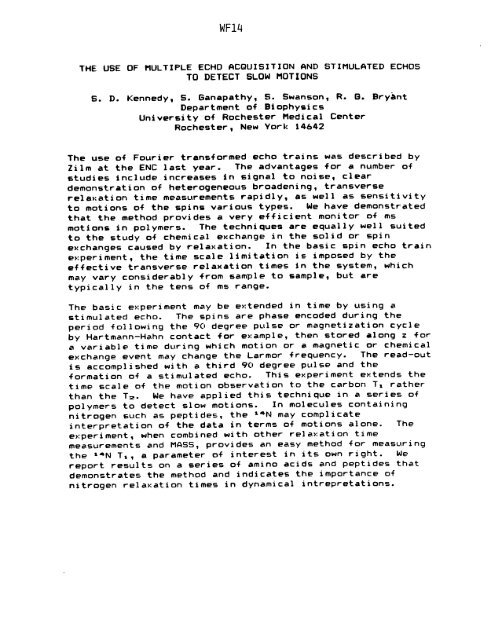th - 1987 - 51st ENC Conference
th - 1987 - 51st ENC Conference
th - 1987 - 51st ENC Conference
Create successful ePaper yourself
Turn your PDF publications into a flip-book with our unique Google optimized e-Paper software.
WF14<br />
THE USE OF MULTIPLE ECHO ACQUISITION AND STIMULATED ECHO5<br />
TO DETECT SLOW MOTIONS<br />
S. D. Kennedy, S. Ganapa<strong>th</strong>y, S. Swanson, R. 8. Bryant<br />
Department of Biophysics<br />
University of Rochester Medical Center<br />
Rochester, New York 14642<br />
The use of Fourier transformed echo trains was described by<br />
Zilm at <strong>th</strong>e <strong>ENC</strong> last year. The advantages for a number of<br />
studies include increases in signal to noise, clear<br />
demonstration of heterogeneous broadening, transverse<br />
relaxation time measurements rapidly, as well as sensitivity<br />
to motions of <strong>th</strong>e spins various types. We have demonstrated<br />
<strong>th</strong>at <strong>th</strong>e me<strong>th</strong>od provides a very efficient monitor of ms<br />
motions in polymers. The techniques are equally well suited<br />
to <strong>th</strong>e study of chemical exchange in <strong>th</strong>e solid or spin<br />
exchanges caused by relaxation. In <strong>th</strong>e basic spin echo train<br />
e~:periment, <strong>th</strong>e time scale limitation i~ imposed by <strong>th</strong>e<br />
effective transverse relaxation times in <strong>th</strong>e system~ which<br />
may vary considerably from sample to sample, but are<br />
typically in <strong>th</strong>e tens of ms range.<br />
The basic e~periment may be e~:tended in time by using a<br />
stimulated echo. The spins are phase encoded during <strong>th</strong>e<br />
period ÷ollowing <strong>th</strong>e 90 degree pulse or magnetization cycle<br />
by Hartmann-Hahn contact for example, <strong>th</strong>en stored along z for<br />
a variable time during which motion or a magnetic or chemical<br />
exchange event may change <strong>th</strong>e Larmor frequency. The read-out<br />
is accomplished wi<strong>th</strong> a <strong>th</strong>ird 90 degree pulse and <strong>th</strong>e<br />
formation of a stimulated echo. This experiment extends <strong>th</strong>e<br />
time scale of <strong>th</strong>e motion observation to <strong>th</strong>e carbon T, ra<strong>th</strong>er<br />
<strong>th</strong>an <strong>th</strong>e T2. We have applied <strong>th</strong>is technique in a series of<br />
polymers to detect slow motions. In molecules containing<br />
nitrogen such as peptides~ <strong>th</strong>e "4N may complicate<br />
interpretation of <strong>th</strong>e data in terms of motions alone. The<br />
e~:periment, when combined wi<strong>th</strong> o<strong>th</strong>er rela~:ation time<br />
measurements and MASS~ provides an easy me<strong>th</strong>od for measuring<br />
<strong>th</strong>e "4N T~, a parameter of interest in its own right. We<br />
report results on a series of amino acids and peptides <strong>th</strong>at<br />
demonstrates <strong>th</strong>e me<strong>th</strong>od and indicates <strong>th</strong>e importance of<br />
nitrogen relaxation times in dynamical intrepretations.













